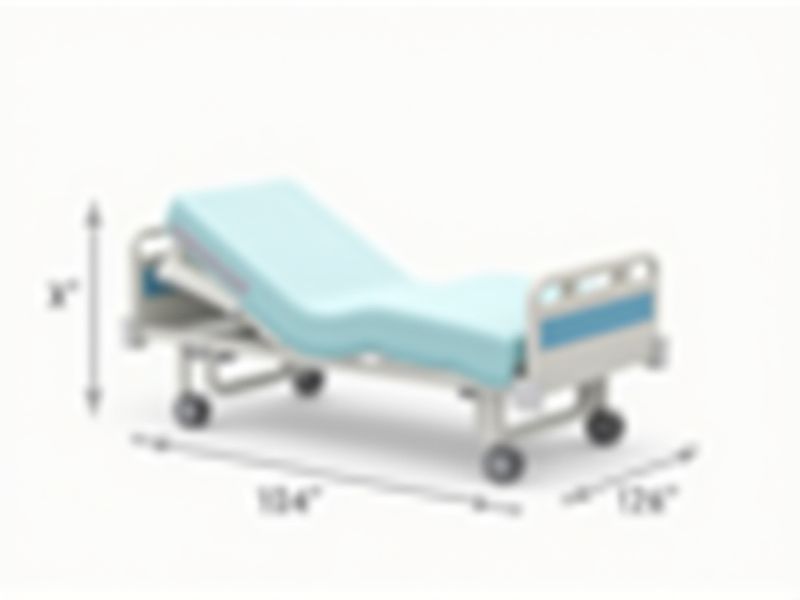
Hospital beds are typically designed with standard dimensions to ensure patient comfort, safety, and compatibility with medical equipment. A standard hospital bed usually measures around 36 inches (91 cm) in width and 80 inches (203 cm) in length. The bed height is adjustable, generally ranging from about 15 inches (38 cm) to 30 inches (76 cm) from the floor to the top of the mattress. These dimensions allow healthcare providers to easily access and care for patients, while also accommodating a variety of patient sizes and mobility needs.
Length
The standard length of a hospital bed typically ranges from 74 to 80 inches, accommodating various patient needs and ensuring comfort during recovery. A 76-inch length is common for most adult hospital beds, allowing for adequate space for patients of average height. Certain specialized beds, such as those designed for bariatric care, may extend up to 90 inches to support larger body types effectively. Understanding these specifications is crucial for healthcare facilities when selecting beds that prioritize both patient satisfaction and clinical efficiency.
Width
The standard width of a hospital bed typically ranges from 36 to 39 inches, designed to accommodate various patient needs while ensuring comfort and safety. This width allows for ample space for caregivers to maneuver around the bed, facilitating easier access for medical procedures and patient care. In some cases, specialized beds may have widths exceeding 39 inches, catering to patients with specific requirements or conditions. Proper consideration of bed width is crucial for infection control protocols and optimizing space in hospital rooms, ultimately enhancing patient experience and operational efficiency.
Height
Hospital beds typically feature adjustable heights ranging from 24 to 30 inches, accommodating patient needs and enhancing caregiver access. These height settings ensure that patients can easily transfer in and out of bed while also allowing staff to minimize strain during care activities. The standard design often includes electric or manual mechanisms, providing flexibility for individual situations. A properly adjusted bed height significantly contributes to patient safety and comfort, ultimately improving the overall quality of care in healthcare settings.
Mattress Thickness
The standard hospital bed typically features a mattress thickness ranging from 4 to 6 inches, ensuring optimal comfort and support for patients. This thickness is crucial in preventing pressure ulcers, with studies showing that appropriate mattress dimensions significantly reduce the risk of skin breakdown. Modern hospital mattresses often incorporate materials such as memory foam and gel-infused layers, which enhance pressure distribution and enhance overall patient comfort during extended stays. When selecting a hospital bed, you should consider mattress thickness as a key factor in ensuring effective patient care and recovery outcomes.
Adjustable Features
Hospital beds are designed with adjustable features that enhance patient comfort and care, with specific needs accounted for through functionalities like height adjustment, head and foot tilt. Modern electric adjustable beds can modify positions with ease, often utilizing remote controls or integrated touch panels, allowing caregivers to respond swiftly to patient requirements. Many models support up to 500 pounds, ensuring durability and stability for a range of patients, from those needing mobility assistance to those recovering from surgery. Your choice of an adjustable hospital bed can significantly impact the quality of care, promoting better posture and reducing the risk of pressure ulcers.
Weight Capacity
The standard weight capacity for hospital beds typically ranges between 350 to 1,000 pounds, catering to various patient needs. These beds are engineered with durable materials and reinforced frames to ensure safety and stability for patients of different sizes. You should consider beds with adjustable height features, which can assist caregivers during patient transfers and enhance comfort. Regular maintenance and inspections are vital to uphold the structural integrity of hospital beds, ensuring they meet rigorous safety standards.
Side Rail Height
The standard height for hospital bed side rails typically ranges from 14 to 18 inches above the mattress surface. This height is crucial for preventing falls, ensuring patient safety, especially for individuals with limited mobility. Side rails should also allow easy access for caregivers while providing enough support for patients to assist themselves when getting in and out of bed. When selecting a hospital bed, consider the side rail height in relation to the patient's specific needs for optimal comfort and safety.
Wheelbase Width
The standard hospital bed typically features a wheelbase width of approximately 30 to 36 inches, ensuring stability and ease of maneuverability within patient care areas. This width accommodates the majority of hospital corridors and doorways, facilitating seamless transportation of patients. Furthermore, an optimal wheelbase promotes safety, reducing the likelihood of tipping during transfers or adjustments. You can find beds with adjustable wheelbases to fit specific facility requirements, enhancing versatility in patient management.
Headboard/Footboard Attachment
The headboard and footboard attachments of hospital beds are crucial for patient safety and comfort, with standards typically requiring a height of 30 inches to 36 inches from the floor. These attachments must securely fit to prevent any movement during patient transfers, which can reduce the risk of falls. Each hospital bed should also accommodate a maximum weight capacity of 500 pounds, ensuring sturdiness for diverse patient needs. Regular inspections and maintenance of these components play an essential role in ensuring compliance with health regulations and enhancing overall patient experience.
Bed Positioning Capabilities
Hospital bed positioning capabilities significantly influence patient comfort and care efficiency. Modern hospital beds typically feature adjustable head and foot sections, allowing for various positions that cater to patient needs, such as elevating the upper body to facilitate breathing or reducing pressure sores. Studies indicate that proper bed positioning can decrease the incidence of complications such as deep vein thrombosis by up to 50%, greatly enhancing overall patient outcomes. With a market saturation projected to reach $3 billion by 2026, investing in advanced hospital bed technologies is essential for improving healthcare services.
